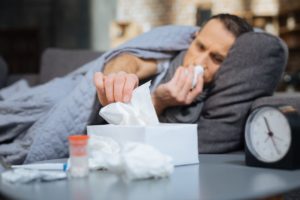Is Sleeping With a Fever Dangerous?
- Often, a cutoff of 100 or 100.4 degrees Fahrenheit is used to define a fever among adults and children over age three.
- Sleeping with a fever below 104 degrees Fahrenheit likely carries little risk for most people, and it may even be helpful in giving your body a chance to rest and fight the infection.
- Most fevers don’t need treatment, unless there’s an underlying cause that requires treatment, but acetaminophen or NSAIDS can help temporarily relieve the fever.
A fever can be unpleasant, as it’s often accompanied by aches, fatigue, chills, and sweating . When a fever strikes, some people want to get in bed and stay there until they feel better, while others worry that sleeping with a fever might not be the best idea. We explore how sleep can help your body when you have a fever, how to recognize when a fever becomes dangerous, and remedies for a fever that you can try at home.
What Is a Fever?
A fever is your body’s way of turning up the heat internally to help fight infection. It’s a self-regulating system and very different from simply getting overheated from the environment around you (known as hyperthermia).
When your immune system detects a threat, such as a virus or, sometimes, a bacterial infection, it releases chemical messengers that tell your brain to raise your core body temperature. This creates a less hospitable environment for germs.
What Temperature Is Considered a Fever?
A person has a fever when their body temperature is higher than what’s normal for them . Often, a cutoff of 100 or 100.4 degrees Fahrenheit is used to define a fever among adults and children over age three .
However, different people have different default body temperatures, and these temperatures can change over time. Adults generally have lower body temperatures than children, and older adults have lower body temperatures than younger adults. Body temperatures naturally fluctuate across each day, dipping in the morning and peaking in the evening. Body temperatures also change throughout the menstrual cycle and with pregnancy.
For these reasons, a single temperature cutoff cannot accurately define a fever for all people. “Context is important,” says physician Dustin Cotliar, M.D. He points out that other symptoms like fatigue, chills, and aches also play a role in determining if someone is sick.
Is It Good to Sleep When You Have a Fever?
“It’s not that sleeping with a fever is dangerous, it’s more that ignoring 104 or 105 fever and ‘riding it out’ is not the best idea,” Dr. Cotliar says. Generally, a fever in and of itself doesn’t cause harm, as long as it’s not higher than 104 degrees Fahrenheit . Sleeping with a fever below 104 degrees Fahrenheit likely carries little risk for most people, and it may even be helpful in giving your body a chance to rest and fight the infection.
Among otherwise healthy people, fevers are most commonly caused by a temporary viral infection. The presence of other symptoms like runny nose, cough, and sore throat could be clues that suggest a person’s fever is due to a passing virus. Experts speculate that when a person has an infection, getting extra sleep could potentially boost the immune system and help them heal more quickly .
What Happens if I Fall Asleep With a Fever?
If a person has a fever due to an underlying infection, that infection may impact their sleep patterns. For example, they may spend more time asleep and less time awake. While sleeping, they may spend more time in deep sleep, which is thought to be restorative, and less time in rapid eye movement (REM) sleep, when dreams often occur.
Many people report unusual dreams during sleep when they have a fever, a phenomenon called “fever dreams.” Fever dreams often feel more negative than a person’s usual dreams. Fever dreams are also more likely to involve health as a theme, and contain bizarre occurrences and visual distortions, like creatures with oversized limbs and moving walls.
Should I Let My Child Sleep Alone With a Fever?
If a child has a fever due to a temporary illness, it’s important to find a balance of letting them sleep and potentially waking them up to visit the doctor or take medication to prevent a fever from spiking and keep them comfortable . A child’s fever is often due to a virus (upper respiratory infection or stomach bug), though in rare cases, it can have a more serious cause.
If a child is receiving medication for a fever and their fever is low, experts recommend not waking the child up to give them the next dose and instead letting them wake up naturally . “But if the fever has been high (102, 103, or 104 degrees Fahrenheit), then it definitely makes sense to be proactive with dosing the medications in order to prevent the fever from spiking,” says Dr. Cotliar.
In some instances, getting medical attention should take precedence. For example, infants younger than three months of age should always be evaluated by a doctor when they have a fever. “And babies less than 30 days old with a fever should be seen immediately by a doctor,” Dr. Cotliar says. “And in most cases, that should be in an emergency department.”
He recommends always consulting with your pediatrician if you’re concerned about your child’s health. However, there are a few specific examples when seeing your doctor is particularly important:
- Babies and toddlers between three months and three years old with a fever for more than three days or who have a temperature exceeding 102 degrees Fahrenheit
- Children of any age with a fever above 104 degrees Fahrenheit or they have a seizure
- If a skin rash begins while a child has a fever
- If a fever comes and goes for over a week
- Children with a chronic illness like heart disease or cancer with a fever
Why Do Fevers Spike at Night?
A person’s body temperature fluctuates over the course of each day and night, whether they have a fever or not. Studies have found that a person’s lowest body temperature occurs around 6 a.m. and the highest happens between 4 and 6 p.m.
“As part of the circadian rhythm, cortisol is highest in the morning and then drops in the evening,” Dr. Cotliar says. When cortisol is high, it suppresses the immune system, and when it drops, the immune system can rev up and the fever spikes, he says.
The difference between a person’s lowest and highest daily temperature is usually around 1 degree Fahrenheit. When a person has a fever, their body temperature may fluctuate even more than normal.
Regardless of whether a person has a fever or not, their body temperature varies over the course of a day as a result of their circadian rhythms . Circadian rhythms are daily bodily changes controlled by a master clock in a person’s brain. They are majorly impacted by exposure to light and darkness, and they help prepare a person to be active or asleep.
When Does a Fever Become Dangerous?
On its own, a fever up to 104 degrees Fahrenheit usually isn’t dangerous for most people — though it’s very unpleasant. In fact, the fever often helps the body fight an infection.
“Even though a fever of 103 or 104 isn’t necessarily dangerous in its own right, such a high fever can sometimes be a sign of a more serious infection, especially in adults,” Dr. Cotliar says. In general, a person should consult their doctor if their fever lasts more than 24 hours.
However, when a fever exceeds 104 degrees and reaches 105 or 106 degrees Fahrenheit, it may damage the body . Fevers in these temperature ranges can lead to organ failure.
When to Go to the ER for a Fever?
While most fevers do not require immediate medical attention, some do. If a person is experiencing a fever and any of the following warning signs, they should see a doctor, whether that is their own doctor or a doctor in an emergency room.
- A temperature higher than 104 degrees Fahrenheit
- Confusion or disorientation
- A stiff neck
- A bad headache
- Rash
- Low blood pressure and dizziness
- Increased heart rate
- Rapid breathing or feeling short of breath
- Recent travel to a location with tropical infectious disease, like malaria
- History of a suppressed immune system
How Can You Treat a Fever at Home?
If you are an adult with a fever lower than 104 degrees Fahrenheit and no warning signs suggesting you should seek immediate medical attention, there are ways you can contend with your fever at home. Most fevers don’t need treatment, unless there’s an underlying cause that requires treatment, but there are some things you can do that may help you feel more comfortable.
If you want to take something to help temporarily relieve the fever, try acetaminophen or NSAIDS like ibuprofen. But first, make sure the medication doesn’t interact with your current medications and is safe with any medical condition you have. For example, people with liver disease shouldn’t take acetaminophen, and those with kidney or cardiovascular disease or ulcers shouldn’t take NSAIDS.
Stay home instead of going to work or out for social activities while you have a fever. While at home, increase your fluid intake to stay hydrated. Get plenty of rest, and allow yourself to sleep as much as you feel like you need to.
References
10 Sources
-
Bush, L. M. (2020, July). Fever. Merck Manual Professional Version.
https://www.merckmanuals.com/professional/infectious-diseases/biology-of-infectious-disease/fever -
Dinarello, Charles A., M.D. (2024, November 26). Pathophysiology and treatment of fever in adults. UpToDate.
https://www.uptodate.com/contents/pathophysiology-and-treatment-of-fever-in-adults -
Ward, Mark A., M.D. (2024, July 29). Fever in infants and children: Pathophysiology and management. UpToDate.
https://www.uptodate.com/contents/fever-in-infants-and-children-pathophysiology-and-management -
Bush, L. M. (2020, July). Fever in adults. Merck Manual Consumer Version.
https://www.merckmanuals.com/home/infections/biology-of-infectious-disease/fever-in-adults -
Ibarra-Coronado, E. G., Pantaleón-Martínez, A. M., Velazquéz-Moctezuma, J., Prospéro-García, O., Méndez-Díaz, M., Pérez-Tapia, M., Pavón, L., & Morales-Montor, J. (2015). The Bidirectional Relationship between Sleep and Immunity against Infections. Journal of immunology research, 2015, 678164.
https://pubmed.ncbi.nlm.nih.gov/26417606/ -
Schredl, M., & Erlacher, D. (2020). Fever dreams: An online study. Frontiers in Psychology, 11, 53.
https://pubmed.ncbi.nlm.nih.gov/32047464/ -
Ward, Mark A., M.D. (2024, February 29). Patient education: Fever in children (Beyond the Basics). UpToDate.
https://www.uptodate.com/contents/fever-in-children-beyond-the-basics -
Section on Clinical Pharmacology and Therapeutics, Committee on Drugs, Sullivan, J. E., & Farrar, H. C. (2011). Fever and antipyretic use in children. Pediatrics, 127(3), 580–587.
https://pubmed.ncbi.nlm.nih.gov/21357332/ -
National Institute of General Medical Sciences. (2023, December 11). Circadian rhythms.
https://www.nigms.nih.gov/education/fact-sheets/Pages/circadian-rhythms.aspx -
Merck Manual Consumer Version. (2022, February). Quick facts: Fever in adults.
https://www.merckmanuals.com/home/quick-facts-infections/biology-of-infectious-disease/fever-in-adults

































































